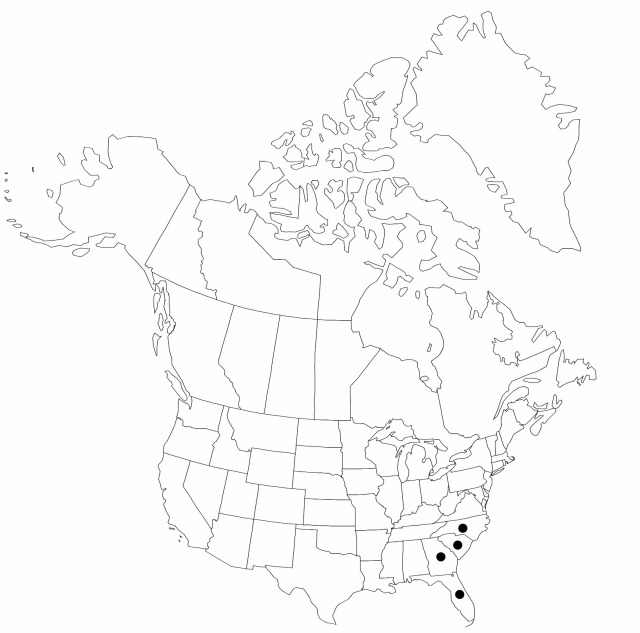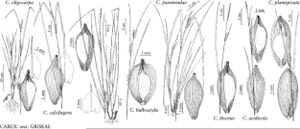Difference between revisions of "Carex calcifugens"
Novon 12: 512, fig. 2. 2002.
FNA>Volume Importer |
imported>Volume Importer |
||
| (3 intermediate revisions by 2 users not shown) | |||
| Line 33: | Line 33: | ||
-->{{#Taxon: | -->{{#Taxon: | ||
name=Carex calcifugens | name=Carex calcifugens | ||
| − | |||
|authority=Naczi | |authority=Naczi | ||
|rank=species | |rank=species | ||
| Line 48: | Line 47: | ||
|publication year=2002 | |publication year=2002 | ||
|special status= | |special status= | ||
| − | |source xml=https:// | + | |source xml=https://bitbucket.org/aafc-mbb/fna-data-curation/src/2e0870ddd59836b60bcf96646a41e87ea5a5943a/coarse_grained_fna_xml/V23/V23_833.xml |
|genus=Carex | |genus=Carex | ||
|section=Carex sect. Griseae | |section=Carex sect. Griseae | ||
Latest revision as of 21:43, 5 November 2020
Plants densely cespitose; rhizome internodes 0.2–7 mm, 1.2–2.2 mm thick. Culms sparingly purple-red to 2.7–5.2(–5.6) cm high at base, 14–37 cm; longest vegetative shoots 23–45 cm, (0.8–)1.4–1.6 times as tall as culms. Leaves: nonbasal sheaths glabrous; blades green, widest blades 2.6–4 mm wide, smooth abaxially. Inflorescences 19–34 cm, (0.88–)0.94–0.99 of culm height; internode between proximalmost scales in proximalmost spike 3–4.3 mm; internode between distal lateral spikes (1–)2.6–12 cm; longest internode (per plant) between distal lateral spikes 5.2–12 cm; peduncle of terminal spike 3.1–54(–73) mm, longest per plant 17–54(–73) mm; proximal bract sheaths tight, apex concave or truncate; ligules 1–4.9(–9.6) mm; blades uniformly green, blade of distalmost lateral bract exceeding terminal spike, longest (per plant) bract blade of distalmost lateral spike 6.1–15 cm. Spikes 4–5 spikes, widely separate or distal 2–3 spikes overlapping, proximalmost spike usually basal; lateral spikes pistillate, with 2–8 perigynia, longest spikes per plant with 5–8, 11–17 × 4.5–8.5 mm, ratio of longest lateral spike length (in mm) to flower number = 2.2–2.4; terminal spike 8–35 × 1.4–2.5 mm, longest per plant 14–35 mm, exceeding distlmost lateral spike. Pistillate scales 3.6–5.7 × 1.8–2.1(–2.4) mm, body (2.2–)2.5–3 mm, midrib prolonged as awn 01–3.2 mm. Staminate scales 4.3–5.8 × 1.4–1.9 mm, apex usually acute, occasionally obtuse, awnless. Anthers 3.8–4.2 mm. Perigynia distichously imbricate, prominently 48–63-veined, obovate or narrowly obovate, obtusely trigonous in cross section, (3.7–) 3.9–5 × 1.6–2(–2.1) mm, 2.1–2.5(–2.7) times as long as wide, 1.5–2 times as long as achene bodies, base gradually tapered, apex contracted; beak straight or excurved 10–30°, (0.4–)0.6–1 mm, 0.08–0.21 of perigynium length. Achenes, 2.6–3.4 × 1.4–1.9 mm, body 2–2.6 mm, tightly enveloped by perigynia; stipe straight, 0.2–0.5(–0.7) mm; beak straight, (0.1)–0.2(–0.3) mm.
Phenology: Fruiting spring.
Habitat: Mesic deciduous forests, in sandy loams and sands, usually on stream banks slopes
Elevation: 0–40 m
Distribution

Fla., Ga., N.C., S.C.
Discussion
Of conservation concern.
Carex calcifugens is rare, local, and usually occurs in small populations. It frequently associates with C. abscondita and C. striatula.
Selected References
None.
